
Published:
Medically Reviewed by Sam Downing, SIS40215 Certificate IV in Fitness
Readtime: 20 min
Every product is carefully selected by our editors and experts. If you buy from a link, we may earn a commission. Learn more. For more information on how we test products, click here.
If you are looking to build size and strength in your upper body, incorporating a few of the best shoulder exercises into your regime is a must-do. Critical to developing a complete routine, shoulder workouts are designed to widen the upper back and bring you one step closer to that desirable V-shape. For men, strengthening your delts can give you the appearance of a slimmer waist while adding definition to your overall physique, but the benefits don’t stop there. Studies have shown that engaging in shoulder workouts can help relieve pain and decrease the possibility of future dislocations. When all is said and done, you want a better body and that alone is enough reason to hop on board.
Best Shoulder Exercises
From dumbbell shoulder press workouts to reverse cable crossovers, you’ll find all the shoulder exercises you need below. One thing to be aware of: shoulder complaints are one of the most common reasons for a trip to the physio. The shoulder is a complex joint and must be respected, so take care with your form, don’t lift unsafe amounts of weight, and check in with a health professional if you experience shoulder pain that doesn’t go away after a week or so of rest.
Another quick note: if you’re looking to do a shoulder workout for mass, you’ll want to start each routine with the most intense exercises. Without further ado, here are the best shoulder exercises for men.
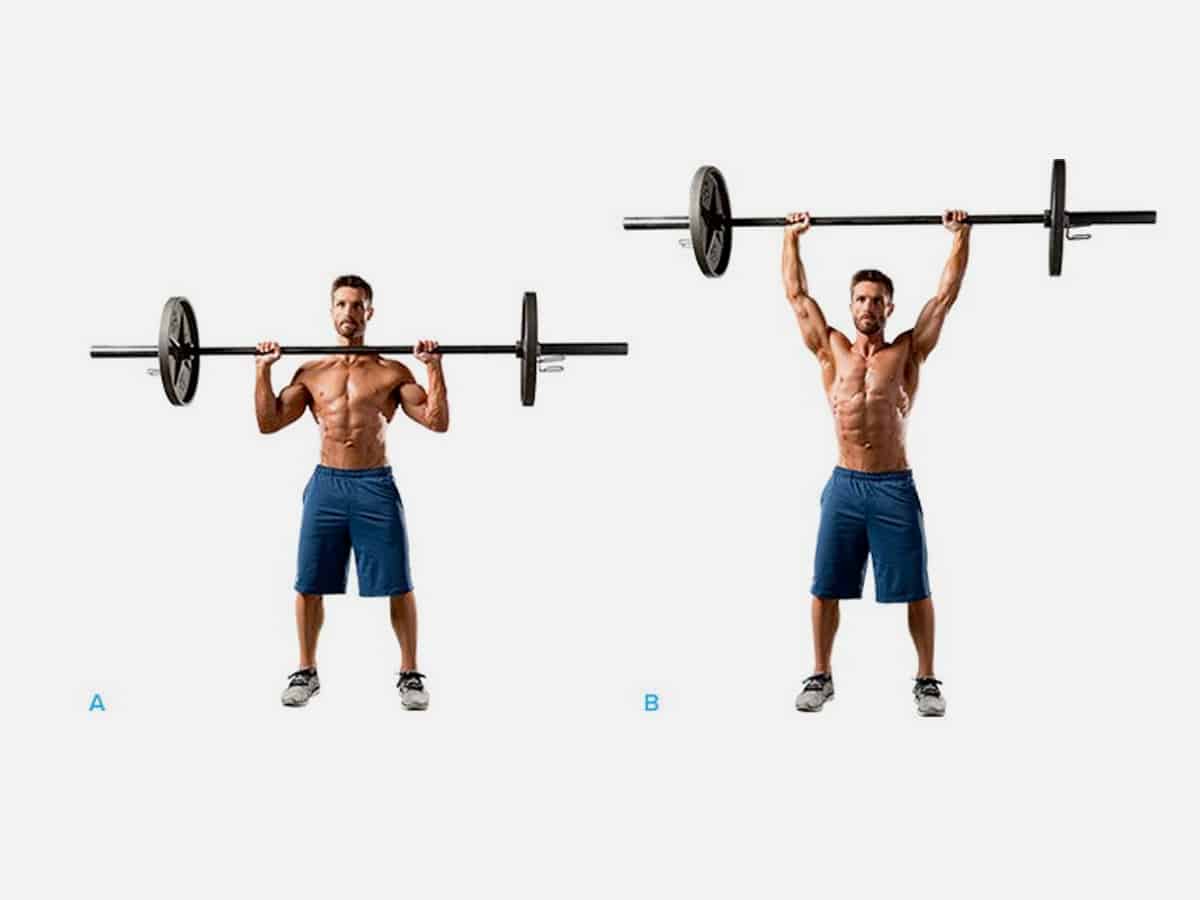
1. Barbell Overhead Shoulder Press
A barbell overhead shoulder press (aka barbell standing shoulder press) works not just your shoulders, but most of your body. That makes it a terrific core strengthener and mass builder, among other things. To start,
- Put your feet at shoulder-width, and engage your core and glutes as you hold a barbell at your shoulders, palms facing forward.
- Next, push the bar upward and squeeze your shoulder blades together at the peak.
- Lower steadily and carefully.
- At no point should your lower back arch — keep your core engaged to stop this from happening.
Why it Works: The reason why the overhead press is such an effective shoulder exercise is due to its ability to develop upper extremity strength and explosive pushing ability. Importantly, the movement is also incredibly versatile, with several adaptations able to be substituted where necessary. If you are wondering whether a behind-the-back or in-front-of-the-head press is more effective, studies have shown the two movements, while similar, actually work different muscles.
According to a study published in The Journal of Sport and Health Science, the in-front technique commenced in the lordotic position, whilst behind the head technique commenced in kyphotic position. The range of motion remains comparable between the two, however, results indicate a significant difference between genders. Males were able to maintain a flat or normal lumbar lordosis when shoulder training, whereas females tended to kyphotic, meaning men may see better results with the in-front technique. (9)
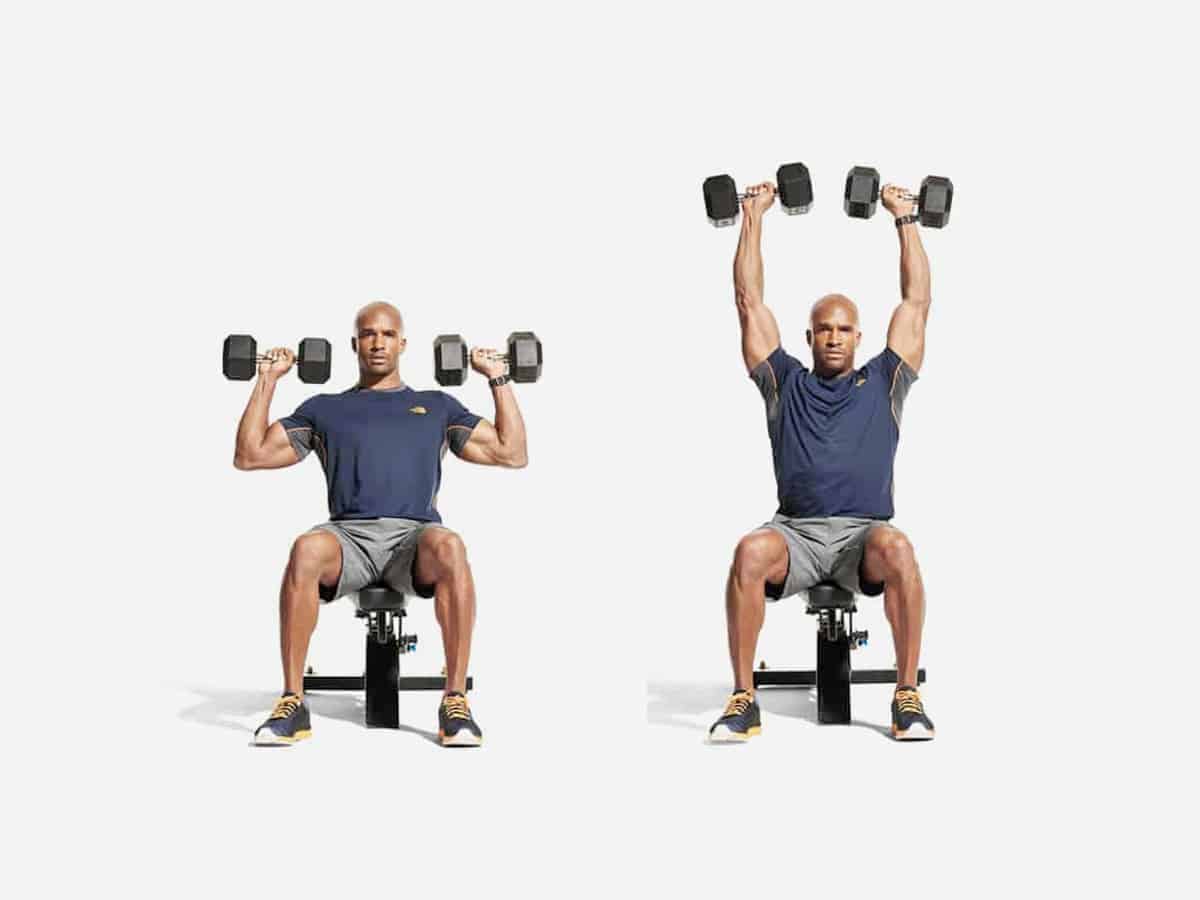
2. Seated Dumbbell Shoulder Press
A proper deltoid workout simply isn’t complete without the seated dumbbell shoulder press. In fact, some say these shoulder workouts with dumbbells are an entire deltoid regimen unto itself, targeting the anterior, lateral, and posterior deltoid muscles (with an emphasis on the middle delts). Meanwhile, lifting two separate dumbbells (as opposed to using a machine) prevents you from using one side of your body over the other, thereby retaining firmer balance and distribution. Naturally, a fair amount of coordination is required to pull this one off, especially when you increase the weights.
To perform a seated dumbbell shoulder press,
- Sit on a low-back bench and hold a dumbbell in each hand at shoulder level, palms facing forward.
- Keeping your head and spine perfectly straight, lift the dumbbells overhead toward one another, stopping just short of having them touch at the top.
- Hold the position for a few seconds and then carefully reverse course. Repeat.
- Again, it’s important to keep your core engaged during this movement — your lower back shouldn’t arch.
Why it Works: While this movement is quite similar to the overhead barbell press, the seated dumbbell shoulder press does introduce some differing parameters. Most notably, when using a pair of dumbbells instead of a barbell, you are forced to independently control the dumbbells. As a result, performing presses on dumbbells should lead to greater instability, which requires more effort and could deliver better results with your shoulder training. (10)
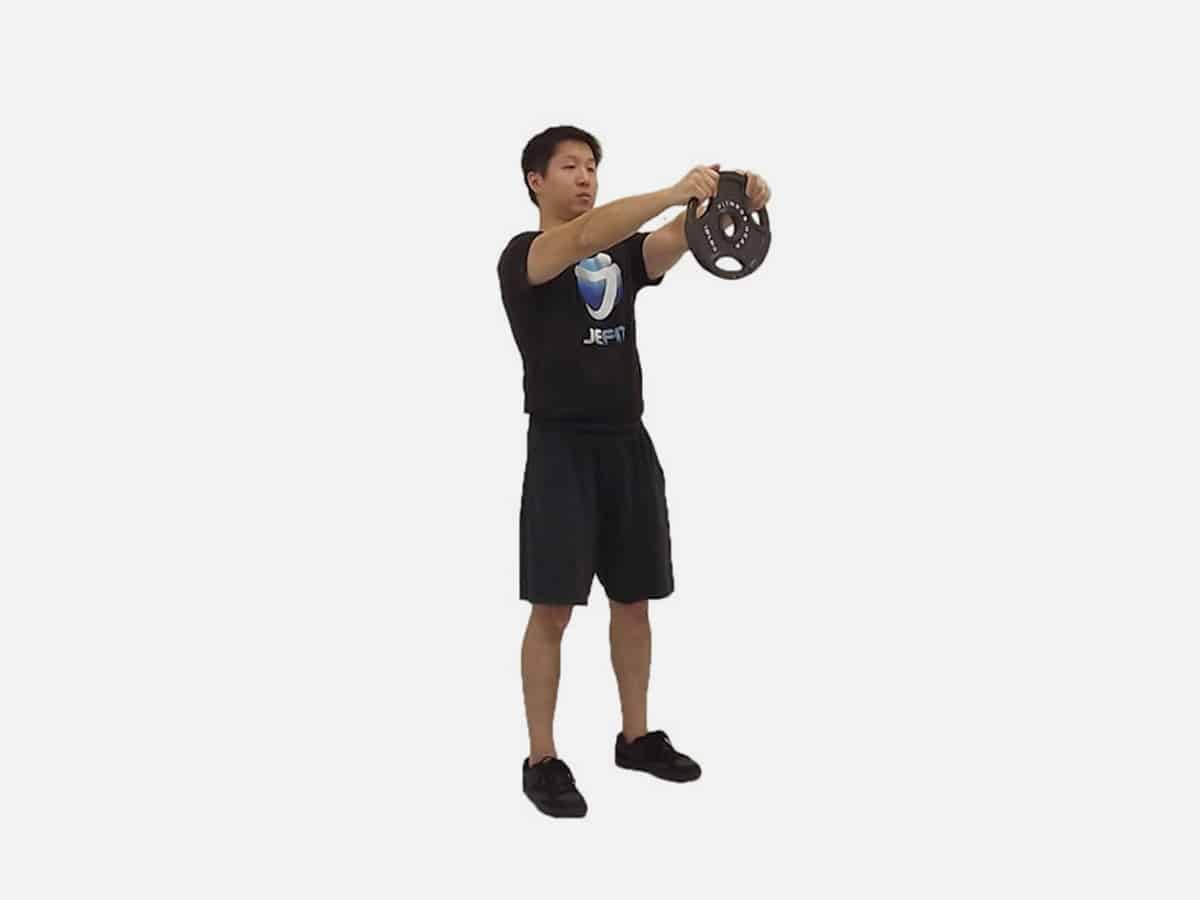
3. Front Raise
You can use either a weight plate or barbell for this shoulder workout, which targets the anterior delts. No matter what you decide to use, prepare for a seriously intense time with one of the best shoulder workouts for mass. Don’t max out on the weight, as it will quickly turn healthy pain into unhealthy injury.
To execute,
- Keep your hands at hip height as you hold the weight in front of you.
- Your feet should be even with your shoulders and your core should be tight.
- Next, retract your shoulder blades and keep your arms straight as you lift the weight to shoulder level.
- Breathe steadily and lower the weight carefully.
- Repeat.
Why it Works: A simple movement, the front raise is one of the most effective shoulder exercises you can perform. A recent study designed to measure the muscle activation of different lateral movements found that of all exercises assessed, Pectoralis major showed greater Normalized surface electromyographic root mean square (sEMG RMS) in frontal raise. (11) This form of shoulder training, in turn, proved to be critical in increasing muscle strength and promoting hypertrophic response.
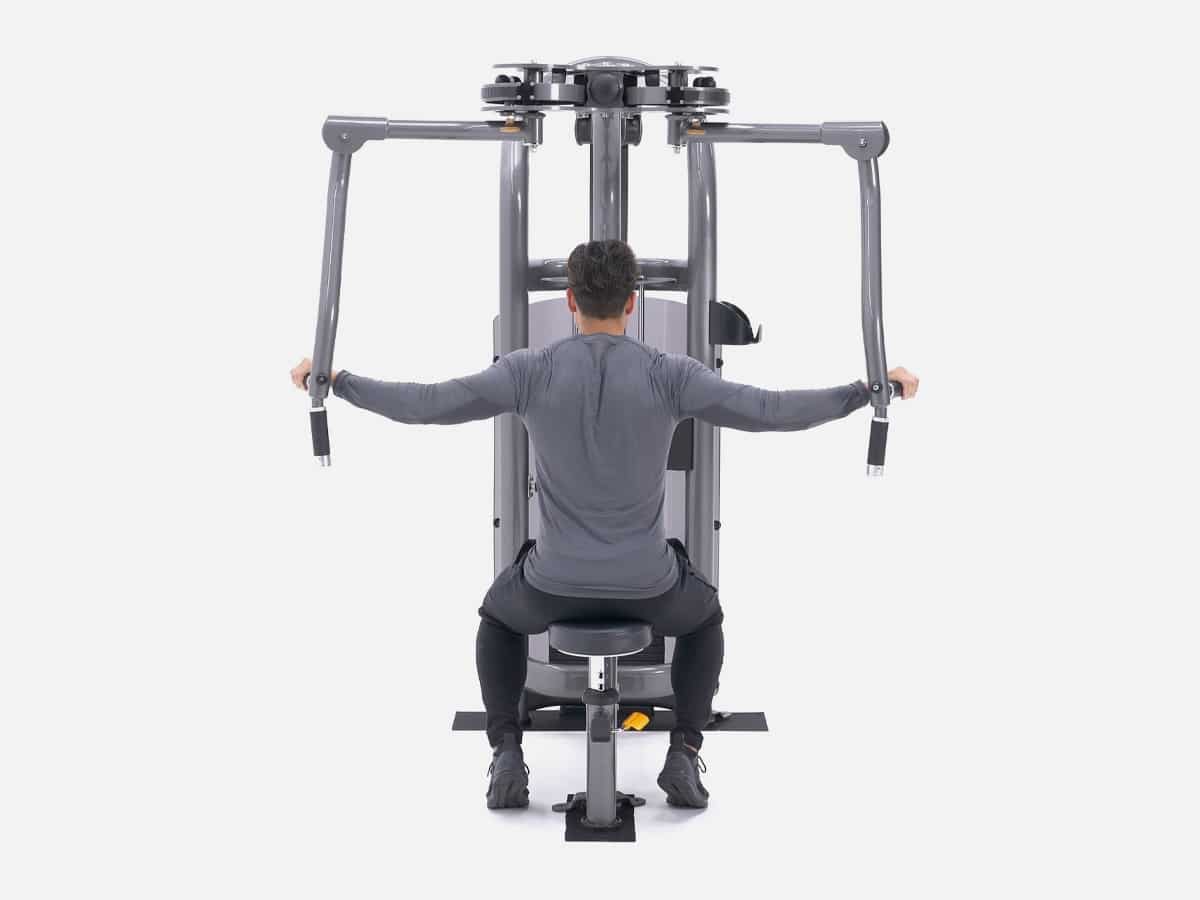
4. Reverse Pec Dec Fly
This shoulder exercise targets your posterior delts and requires a pec dec machine. It’s also the perfect chest, back and shoulder workout for building mass. To start;
- Face the machine, and position the seat so that the handles are at shoulder level on either side.
- Next, hold the handles with your palms facing inward.
- Tighten your torso and extend your arms out to the side, pushing through all the way.
- Responsibly return to the starting position.
- Repeat.
Why it Works: The reverse pec dec is a terrific exercise for isolating your rear deltoids and strengthening your upper back. By growing this area, it will help to make your shoulders more defined and rounded, however, that’s not the only benefit. Adding size to your upper back may help with posture and improve your other lifts.
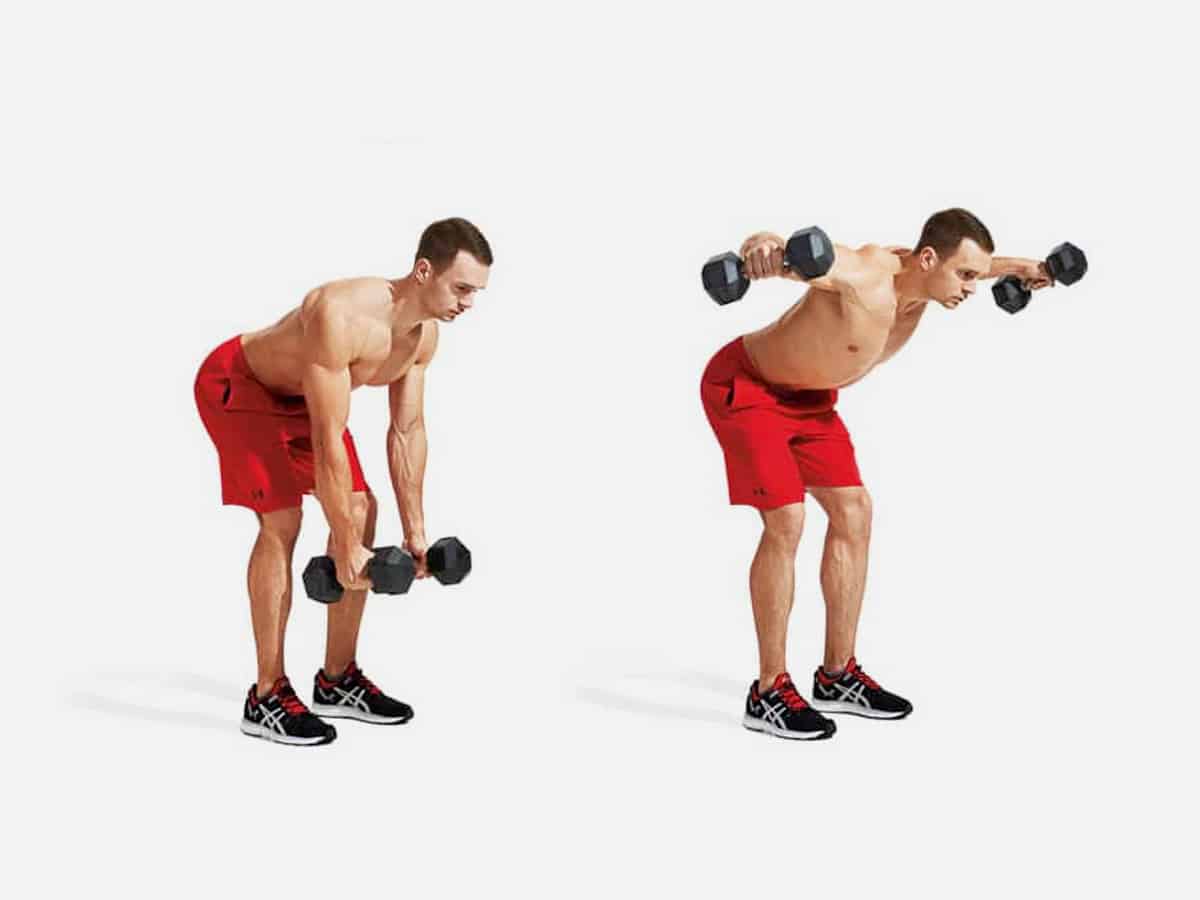
5. Bent-Over Dumbbell Lateral Raise
This wildly effective full shoulder workout targets your middle deltoids, though it also builds upon your overall physique. You can perform it in either a standing (bent-over) or seated position.
- Start with a dumbbell in each hand (not so heavy you can’t control the weight during the movement), keeping your chest up, your back flat, your knees slightly bent, and your eyes focussed toward a fixed point on the floor.
- Now, bend over until your core is basically parallel with the ground, and hang the dumbbells directly underneath you, all while keeping your elbows in a slightly bent position.
- Next, raise both dumbbells up and out to your sides, forming an arc until your upper arms are even with your torso.
- Take a brief pause at the top before lowering the dumbbells back into starting position.
- Repeat.
Why it Works: Much like the front raise, lateral raises promote arm abduction and flexion on the frontal or sagittal plane, respectively. This area is largely used to stimulate the shoulders muscles, which is great if you’re wanting to grow a more rounded upper body. This is due to the impact on the Medial deltoid. A recent study found that this muscle group was highly active during lateral raises, “particularly when the humerus had a neutral or internal rotation”. (11)
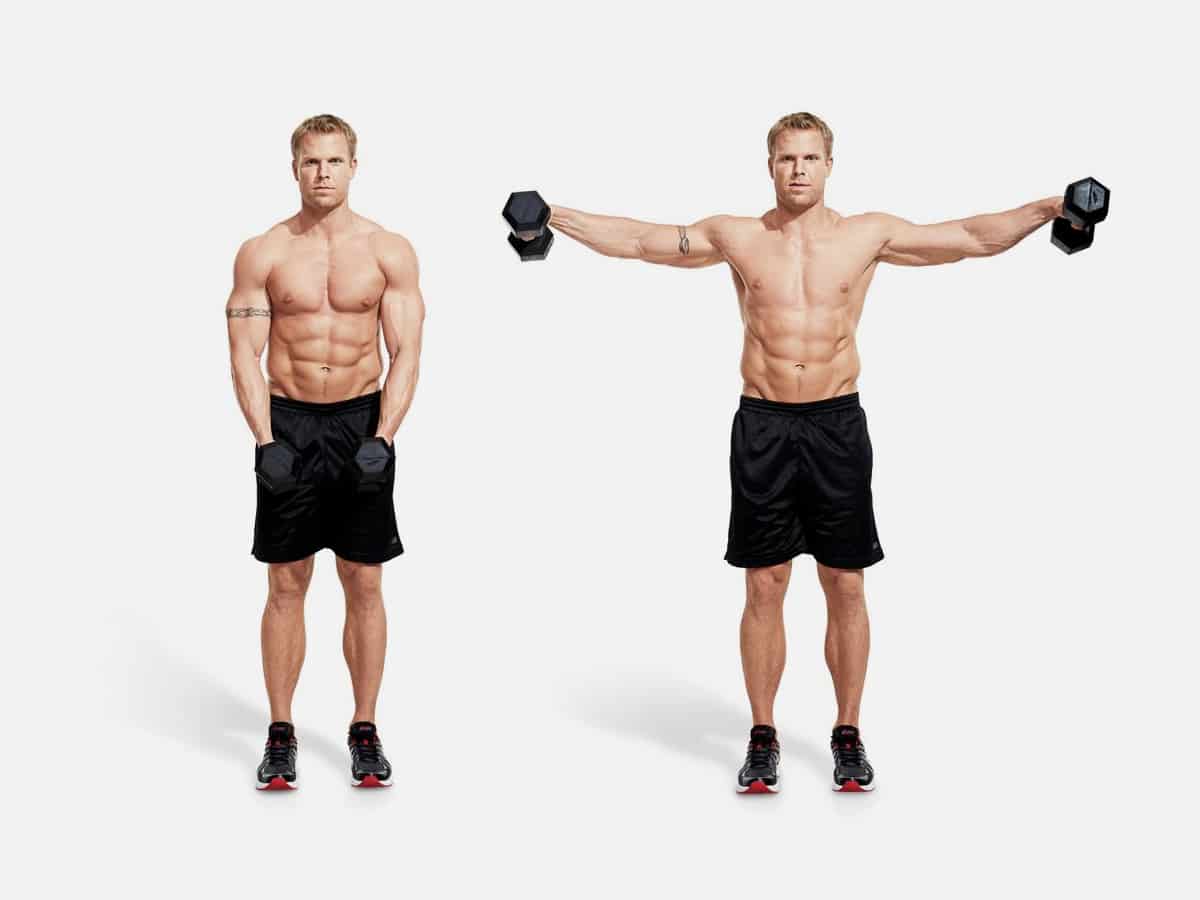
6. Dumbbell Lateral Raise
If you prefer a more traditional lateral raise, look no further than this full shoulder workout. It likewise targets the middle deltoids and works wonders when executed properly.
- Start in the standing position, keeping your feet shoulder-width apart, your abs tight, your chest up, your head straight, and your shoulders pinched. Hold the dumbbells at either side, retaining a neutral grip.
- Now, here comes the hard part. Using just your shoulders and arms, raise the dumbbells a notch above shoulder level.
- Hold for a moment.
- Lower the dumbbells back to the starting position — with control. Don’t let them just drop to your sides.
- Repeat.
Why it Works: Your elbows and hands should be moving together in harmony the entire time, and you should be maintaining a neutral, balanced position. If you find that your core or neck is shifting as you perform each rep (i.e. you’re utilising your body’s momentum), lower the weight accordingly.

7. Push Up
Arguably the simplest shoulder exercise out there, push-ups remain one of the most effective to add to your arsenal. The fundamental move can be performed practically anywhere and requires no outside equipment. Importantly, there is more than one way to do a push-up and each variation has its specific benefits. Here are the best push-up variations for your shoulders:
- Standard Push-Up – The standard push-up is an exercise you may have performed hundreds of times before, generally when attempting a chest exercise, but the movement has some major foundational benefits for your shoulders. To perform, simply get on all fours, extends your legs backwards and lower your upper body into a flat-back position. Using the joint of your elbow as a pivot point, slowly lower yourself to the ground before pressing your body in an upwards motion. For more information on how to do a perfect push-up, check out our full guide.
- Diamond Push-Up – A step above the regular. A diamond push-up involves placing your close together in front of your face during the starting position, making a diamond shape. From here, the stress is more on your outer arm, working the lateral deltoid.
- Wide Stance Push-Up – In this variation, you extend your hands wider apart, placing more emphasis on pectoral muscles and inner shoulder muscles.
- Incline Push-Up – Using a bench, simply elevate your legs to create greater downforce. This variation will place more stress on your front deltoids.
- Pike Push-Up – A favourite of the F45 gang, the Pike Push-up sees you elevate your legs and assume an inverted V-shape. This movement places intense stress on the front deltoids and pectoral muscles, creating a more overall workout of the shoulder region.
Why it Works: While generally regarded as a chest exercise, the push-up is actually a compound movement, requiring several muscle groups to work simultaneously to perform. In order to better target your shoulders, adjusting the height of the start position has been shown to significantly alter results.
A results study in Physical Therapy in Sport found that suspended push-ups at 10 cm resulted in greater activation in the tricep. For shoulder training, particularly in relation to delts, higher activation is achieved by performing push-ups on the floor. (12)
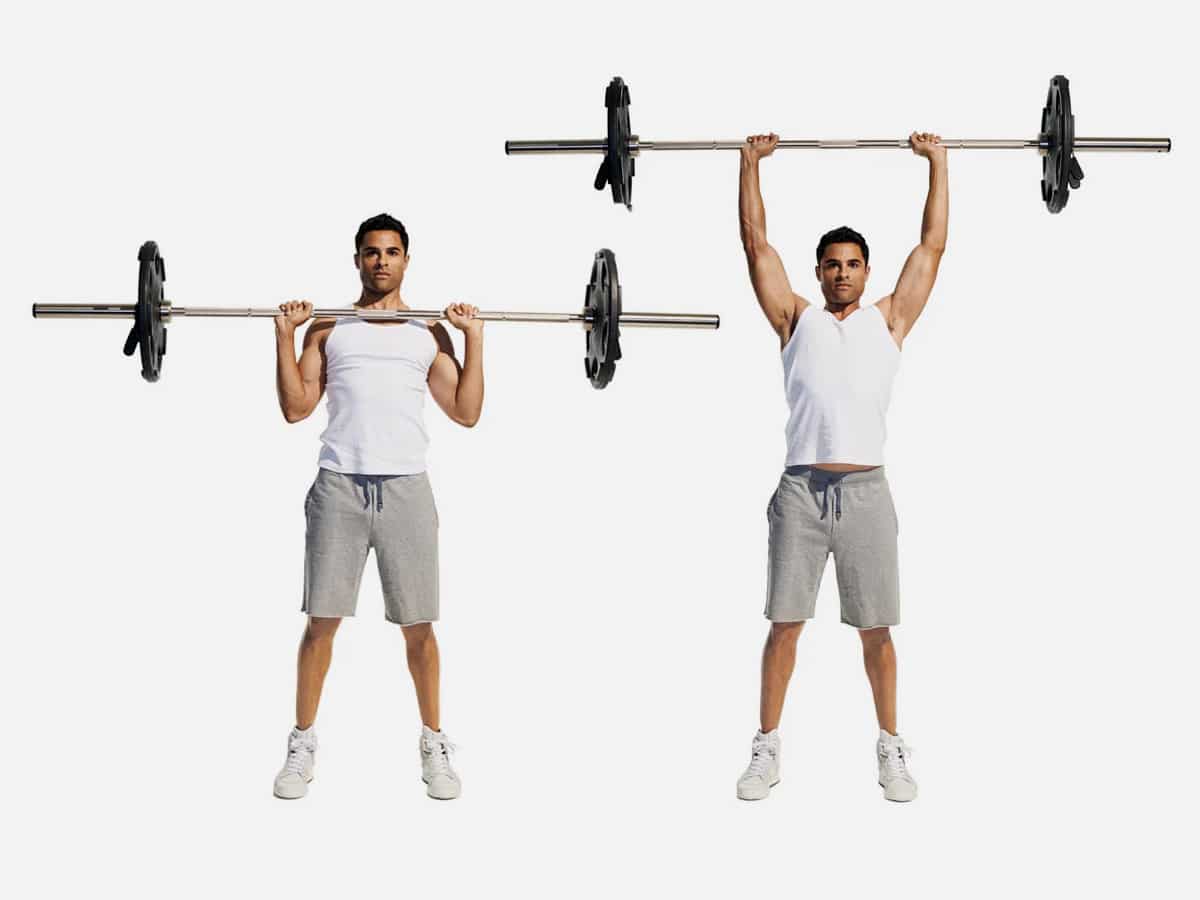
8. Push Press
A staple of heavy-compound workouts, this shoulder exercise is not for novices. However, even the experts usually start light (sometimes using nothing but the bar), adding weight as they go along. Should you master this one, prepare for it to show virtually everywhere on your body. The push press should be performed in the standing position.
- Start by resting the barbell atop your upper chest, with your palms up, your elbows pointed out, and your upper arms parallel to the floor.
- Lower your hips and bend your knees into a quarter squat and then rise upwards with ample thrust, fully extending your arms and elbows as you lift the bar over your head.
- Hold for a moment before returning to the starting position for the next rep.
- Keep your core and glutes engaged, especially at the top of the movement, to protect your lower back.
Why it Works: The push press is a compound movement, meaning several muscle groups have to work together to achieve the movement. it’s similar to the Overhead Press, however, in this instance, you can add a little power from your legs. As a result, you should be able to lift heavier weights, which can lead to increased hypertrophy and greater muscle activation.
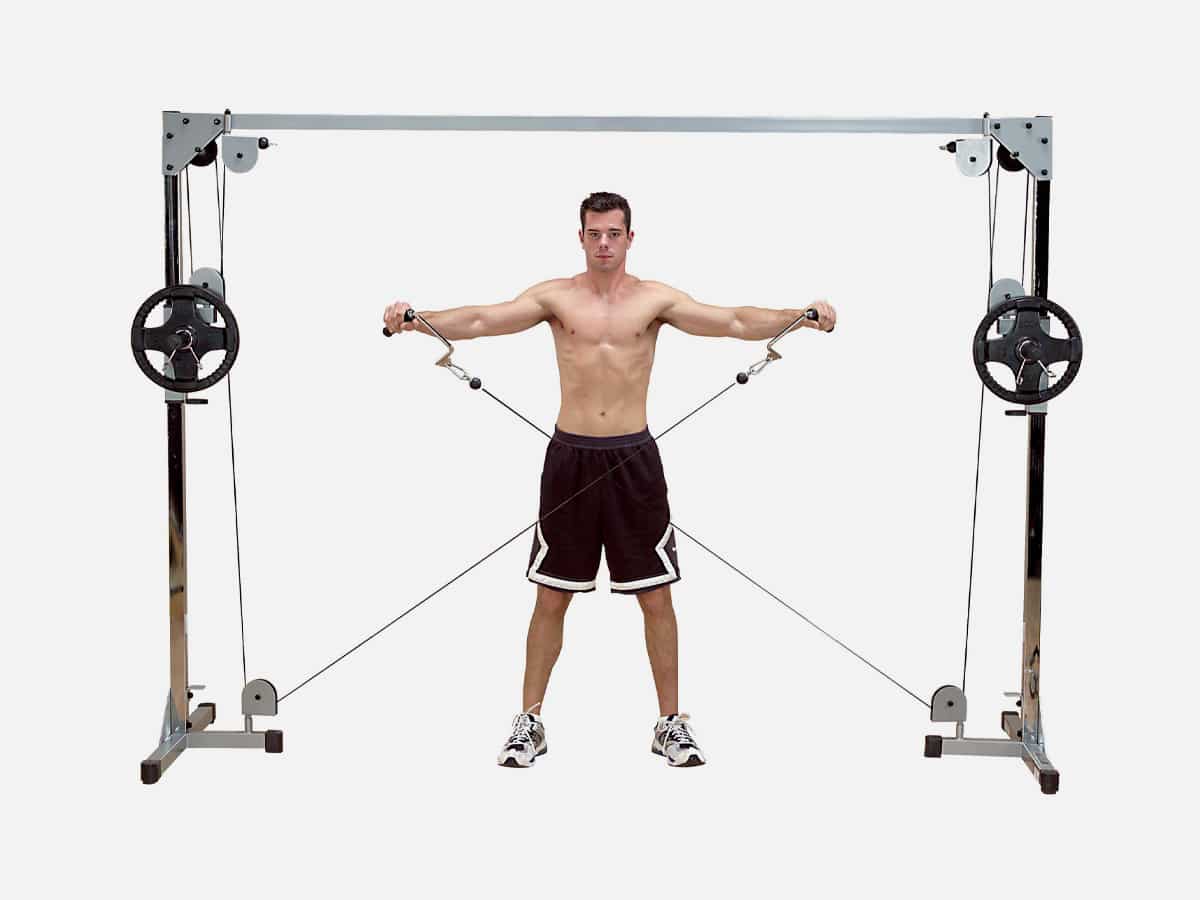
9. Reverse Cable Crossover
You’ll need to attach D-handles to the upper pulley of two cable machines for this popular shoulder gym exercise.
- Grab the handle from the machine on your right using your left hand, and vice versa.
- Draw the cables in so that they form a cross on your chest, keeping your elbows fixed and your arms even with your shoulders.
- Slightly lean forward before lifting the weights on each respective machine in a cross-like fashion, stretching your arms as far as the cables go before bringing them in.
- If possible, increase the weight with each subsequent set.
Why it Works: The reverse cable crossover is another mixed muscle-group movement, specifically targeting the deltoids. Due to the pulling nature of the movement, the exercises drives contraction of the posterior deltoid, teres minor and infraspinatus. When performed correctly, the reverse cable crossover should also see enhanced strain placed on the trapezius at the height of the concentric section.
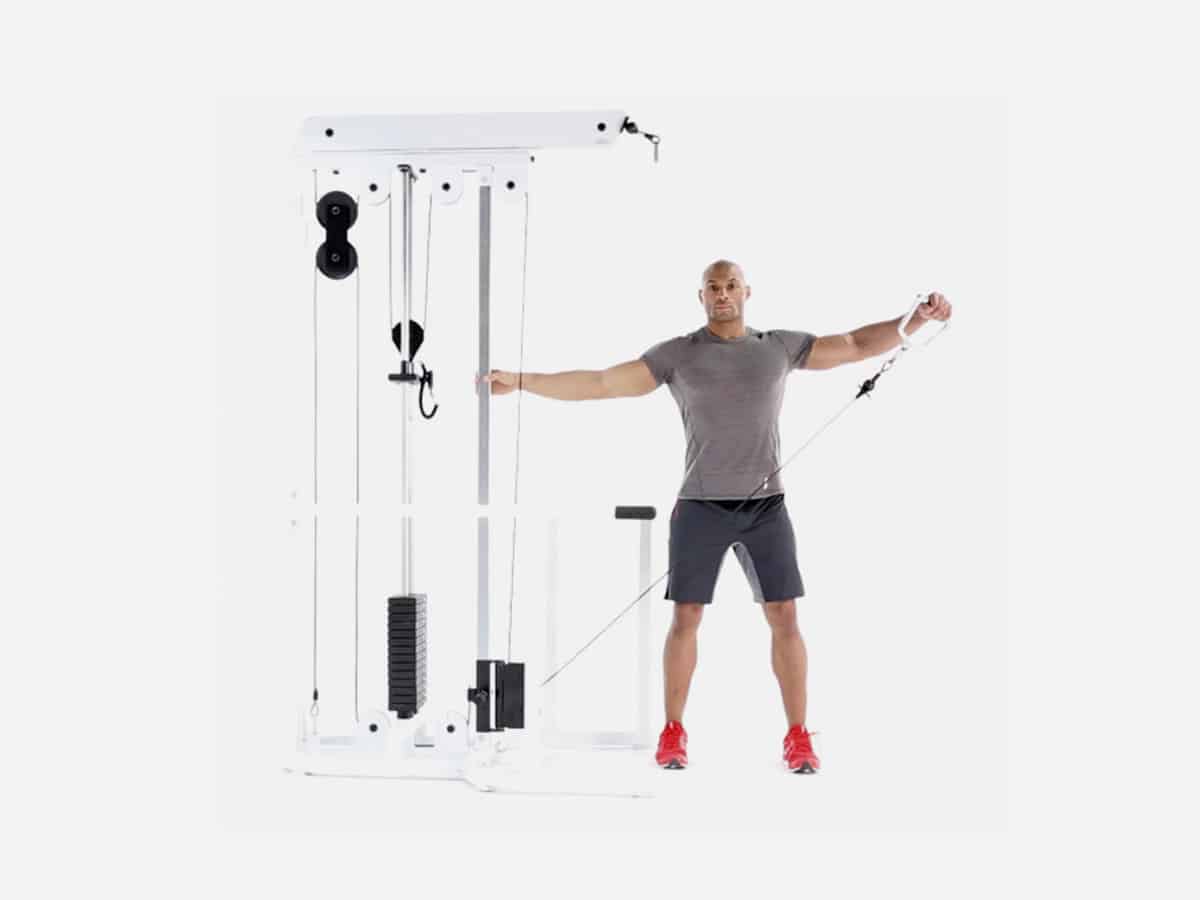
10. One-Arm Cable Lateral Raise
Similar to the reverse cable crossover, this shoulder exercise targets the middle deltoid muscles and delivers ample tension. To start,
- Stand sideways to the cable machine, keeping your feet shoulder-width apart. Using the hand that’s opposite the pulley, grab the D-handle.
- With your abs tight and your shoulders back, raise the cable using just the motion of your arms and shoulders.
- Take your arm just past shoulder level and hold for a few seconds before slowly returning to the original position.
- Repeat as necessary and then switch sides. Your hand and elbow should move in conjunction with one another the entire time.
Why it Works: Similar to a traditional lateral raise, the one-arm cable movement works to isolate the shoulder muscles. As a highly mechanical movement, the exercise is great for adding strain to the side deltoid muscles, while also placing emphasis on the anterior deltoid. Furthermore, by focusing on one arm at a time, you should be able to lift heavier weights.
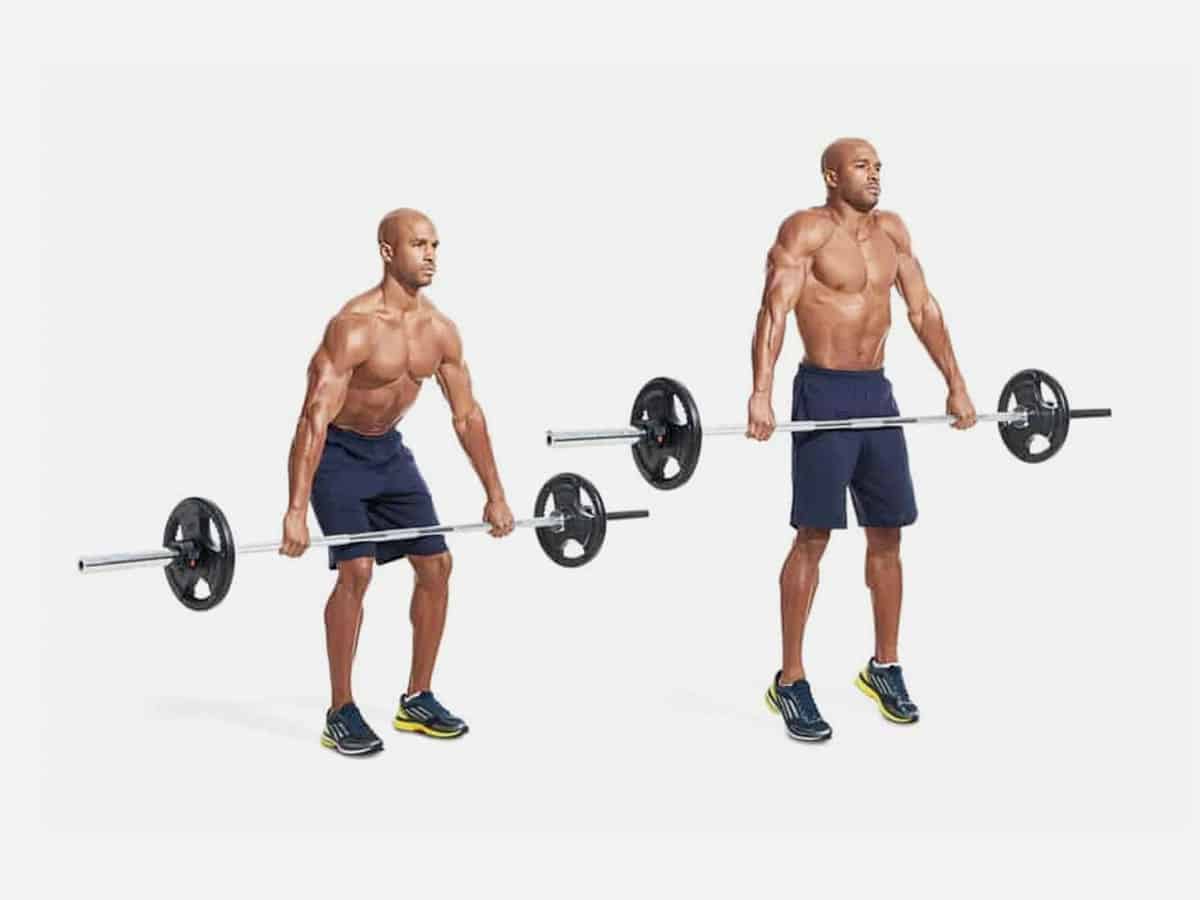
11. Standing Barbell Shrugs
Save this neck and shoulder exercise for the end of your overall routine. This is an advanced exercise, so focus on the basics if you’re a beginner before working up to this movement.
- Keeping your feet even with your shoulders, bend your knees and pick up the barbell, bringing it to waist level.
- Next, lift your shoulders up and back (i.e. “shrug” or pinch them), squeezing for about five seconds before releasing them.
- Keep the movements restricted to your shoulders, meaning your arms should be relatively loose and the barbell should only raise and lower very slightly.
Why it Works: While not an isolated shoulder exercise, barbell shrugs are great for creating a more defined upper section. This movement most closely targets the upper traps, which can help to round out your physique and add size to your back.
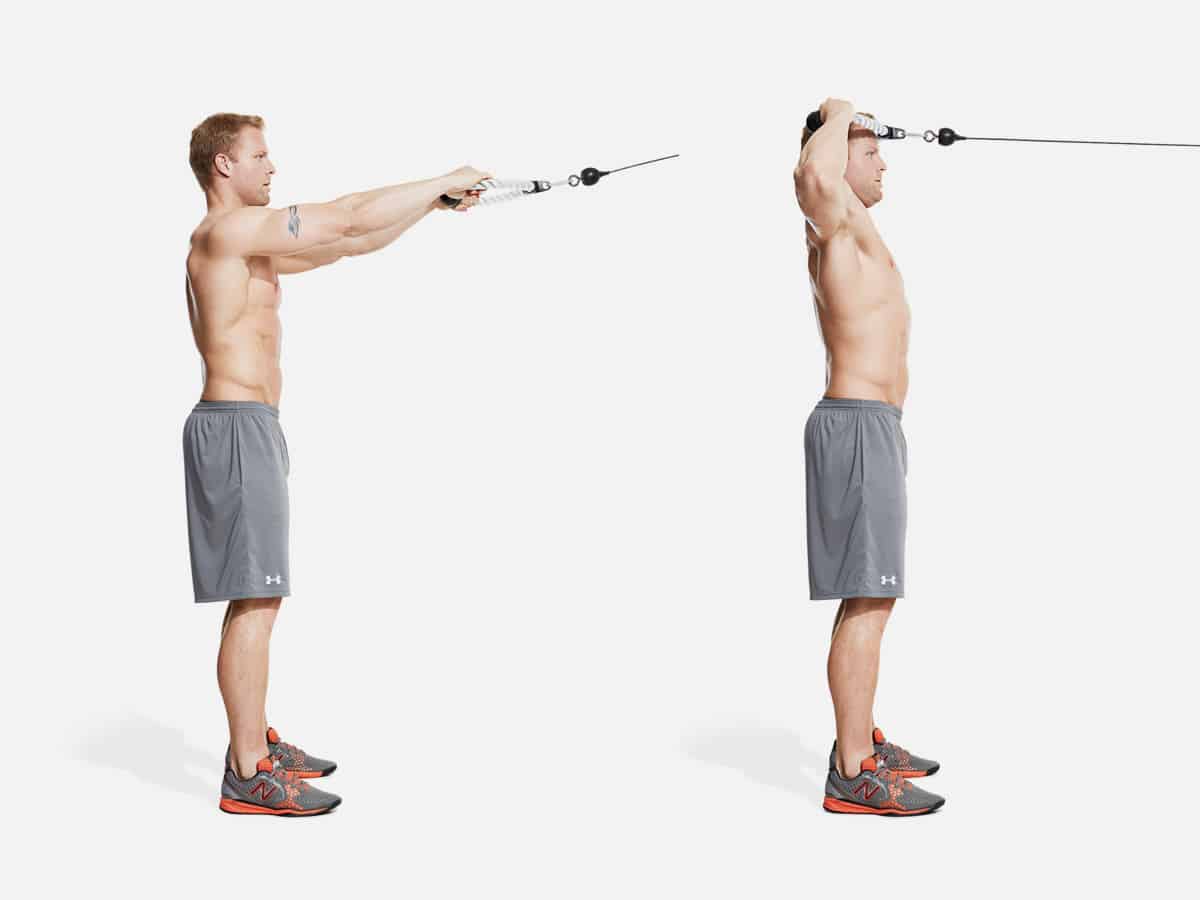
12. Cable Face Pulls
Another shoulder exercise that requires the use of the cable muscle, Face Pulls are important in creating a well-developed back and rear deltoid physique. The movement, while simple, targets your posterior deltoids and trapezius, while also adding further stress to the main components of your shoulders. To complete Cable Face Pulls:
- Stand facing the cable machine
- Set the cable framework to around eye height
- Using the rope connection, clutch each end and raise your arms to shoulder height
- Bring your elbows in and pull the cable towards your face
- Hold and tense your back
- Release slowly
- Repeat
Why it Works: Another shoulder exercise closely related to the rear deltoid, cable face pulls are great for developing the overall shoulder area, in particularly the rhomboids and the external rotators (infraspinatus and teres minor). According to Certified Strength & Conditioning Specialist (CSCS), Ken Grall, Face Pulls are the perfect remedy for poor shoulder positioning. To get the most out of the movement, focus on retracting your shoulder blades as you perform the pulling motion.
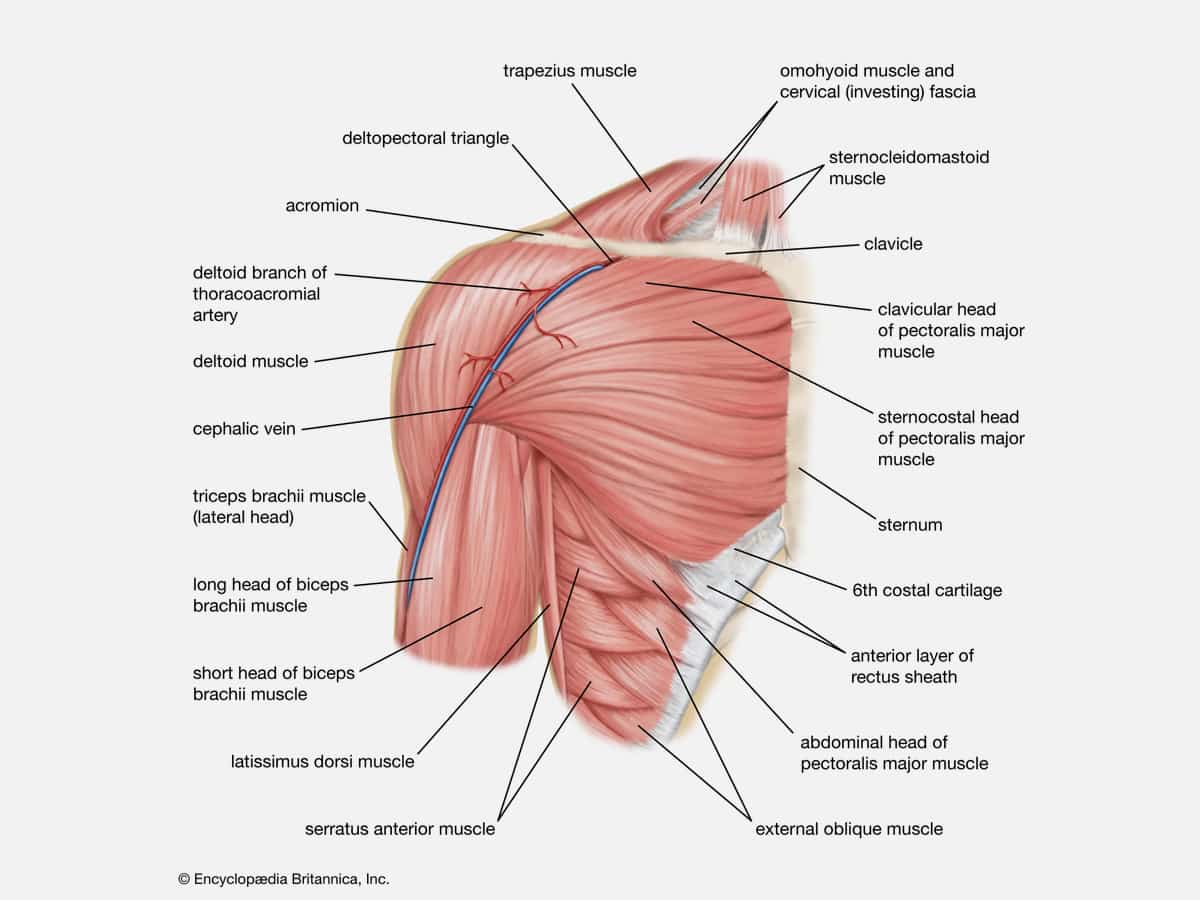
What are Your Shoulder Muscles?
Should shoulder exercises be new to your workout regiment, you’ll soon discover that these muscles develop rather quickly compared to other areas of your body. Don’t take that to mean shoulder exercises are easy, however. Plenty of gym junkies dread shoulder day at the gym, as the workout can get quite intense…presuming you’re doing it properly. To ensure as much, we’ll take you through the best shoulder exercises for men, but first, let’s figure out what shoulder muscles are.
Your shoulder muscles break down into two separate groups: extrinsic muscles and intrinsic muscles. The former starts at the torso and links to the shoulder bones, while the latter start above the upper torso (scapula, clavicle) and connect with the humerus. Within both of these respective groups, you have a range of specific muscles. They are as follows:
Extrinsic Shoulder Muscles
- Trapezius – Shaped like a triangle (hence the name), these shoulder muscles run down the spine and across the shoulder blade, supporting your arm and shoulder when you raise it. You have a trapezius muscle on both your left and right side. (3)
- Latissimus Dorsi -The name of this muscle translates to “broadest muscle in the back” and its physical structure duly abides. More commonly known as your “lat” muscle, it helps with the extension and internal rotation of each arm.
- Levator Scapulae -As its name suggests, the levator scapulae muscle helps lift the scapula bone (shoulder bone), which connects the humerus (upper arm bone) and clavicle (collarbone). (4)
- Rhomboids – These rhombus-shaped muscles are primarily responsible for the retraction of the scapula. They’re located in the middle of your shoulder blades on your upper back, and divided between left and right.
Intrinsic Shoulder Muscles
- Deltoids – Named for the Greek letter delta, this triangle-shaped muscle is located atop the shoulder. It breaks down into three main muscle fibres: anterior, middle, and posterior, which are all connected by way of a thick tendon. The very fact that shoulder exercises are more or less synonymous with working out your “delts” just goes to show how important this muscle actually is. Accordingly, your delts provide a foundation for things like arm rotation and injury prevention. (5)
- Teres Major – This small muscle runs from under the shoulder joint toward the back of the armpit. (6) Due to its association with the latissimus dorsi, teres major has earned the nickname “lat’s little helper.”
- Rotator Cuff – If you’re wondering why your upper arm bone doesn’t pop out of your shoulder socket on a regular basis, you have this group of muscles and tendons to thank. Unsurprisingly, rotator cuff muscles surround the shoulder joint.
Things to Consider for Shoulder Workouts
When it comes to any form of strength training, there are some elements that require specific attention. In order to avoid injury and increase efficacy, here’s what you need to consider with your shoulder workout.
- Warm-Up/Stretch – Warming-up is one of the most important elements of any workout. The process of stretching gradually increases the strain on your cardiovascular system by raising your body temperature. According to a 2007 study published in Sports Med, the increased blood flow to your muscles may help reduce soreness and lessen the risk of injury. (7)
- Incorporate Rest Days – While it might sound detrimental, going super hard in the gym is not always the recipe for success. Overworking your shoulders by performing multiple sets on successive days may lead to increased fatigue. One study performed by the Department of Physical Education and Recreation, Western Kentucky University found that 72 hours of rest between strength training sessions was ideal for full muscle recovery. (8)
Alternatives to Shoulder Exercises
If you are a fitness fanatic looking to bolster your workout routines, don’t stop at shoulder exercises. Below, you’ll find a range of workouts and guides to help you build size and strength.
- How to Train For Your Body Type
- What is Hypertrophy? The Workout Hack Trainers Swear By
- Best Tricep Exercises for Men
- Best Chest Exercises for Men
- Best Bicep Exercises for Men
- Best Trap Exercises for Strength and Size
You’ll also like:
Pelvic Floor Workout: The Best Kegel Exercise for Men
10 Best Core Exercises for Men
Chris Hemsworth’s Thor Diet & Workout Plan
10 Best Chest Exercises for Men
Last medically reviewed on 19 June 2022
Citations
- “The effectiveness of therapeutic exercise for painful shoulder conditions: a meta-analysis”. Journal of Shoulder and Elbow Surgery. September 5, 2011.
- Valenzuela M, Varacallo M. StatPearls (Internet). StatPearls Publishing; Treasure Island (FL): Sep 18, 2021. Anatomy, Shoulder and Upper Limb, Hand Lumbrical Muscles
- Rockwood, Charles A. (January 1, 2009). The Shoulder. ISBN 978-1416034278.
- Brand, R. A. (2008). “Origin and Comparative Anatomy of the Pectoral Limb“. Clinical Orthopaedics and Related Research. 466 (3): 531–42. doi:10.1007/s11999-007-0102-6. PMC 2505211. PMID 18264841.
- Cleveland Clinics (Internet). Deltoid Muscles: What Are They, Anatomy, Location & Function, Accessed 11/7/2022.
- Dave HD, Shook M, Varacallo M. Anatomy, Skeletal Muscle. (Updated 2020 Sep 22). In: StatPearls (Internet). Treasure Island (FL): StatPearls Publishing; 2021 Jan-. Accessed 11/7/2022.
- Woods, K., Bishop, P. & Jones, E. Warm-Up and Stretching in the Prevention of Muscular Injury. Sports Med 37, 1089–1099 (2007).
- McLester, J. R., Bishop, P. A., Smith, J., Wyers, L., Dale, B., Kozusko, J., Richardson, M., Nevett, M. E., & Lomax, R. (2003). A series of studies–a practical protocol for testing muscular endurance recovery. Journal of strength and conditioning research, 17(2), 259–273.
- Mark R. McKean, Brendan J. Burkett, Overhead shoulder press – In-front of the head or behind the head?, Journal of Sport and Health Science, Volume 4, Issue 3, 2015, Pages 250-257, ISSN 2095-2546, https://doi.org/10.1016/j.jshs.2013.11.007.
- Saeterbakken, Atle H.1; Fimland, Marius S.2,3. Effects of Body Position and Loading Modality on Muscle Activity and Strength in Shoulder Presses. Journal of Strength and Conditioning Research 27(7):p 1824-1831, July 2013. | DOI: 10.1519/JSC.0b013e318276b873
- Coratella G, Tornatore G, Longo S, Esposito F, Cè E. An Electromyographic Analysis of Lateral Raise Variations and Frontal Raise in Competitive Bodybuilders. International Journal of Environmental Research and Public Health. 2020; 17(17):6015. Huawei Watch Fit 2 is Like Having a Personal Trainer On Your Wrist
- Sebastien Borreani, Joaquin Calatayud, Juan C. Colado, Victor Tella, Diego Moya-Nájera, Fernando Martin, Michael E. Rogers, Shoulder muscle activation during stable and suspended push-ups at different heights in healthy subjects, Physical Therapy in Sport, Volume 16, Issue 3, 2015, Pages 248-254, ISSN 1466-853X, https://doi.org/10.1016/j.ptsp.2014.12.004.
General FAQ
It’s recommended that you should perform 3-4 sets for 2-3 days per week to hit your total volume training recommendations.
The shoulder shrug stands out as one of the best and simplest exercises. It enhances the strength of the trapezius muscle, a recommendation from physiotherapists for individuals experiencing shoulder and neck pain
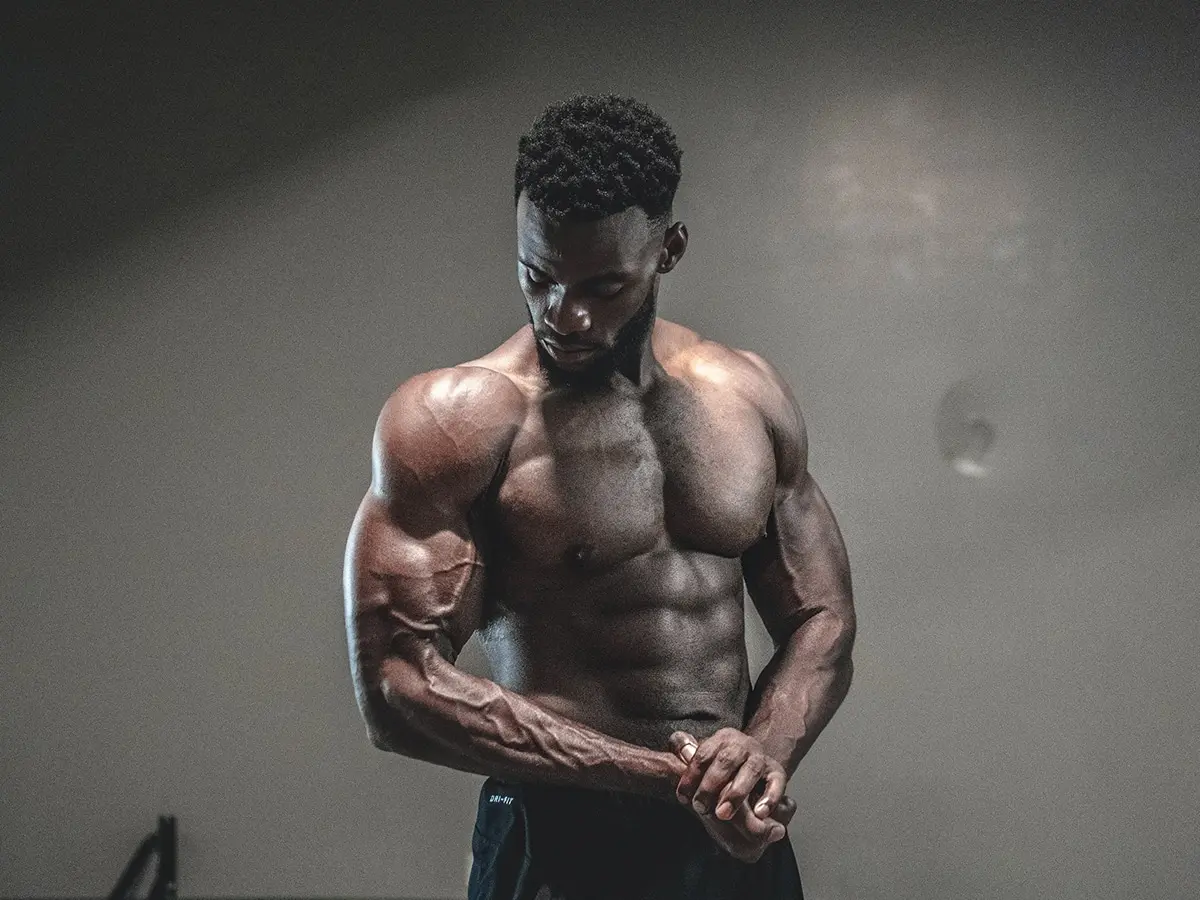














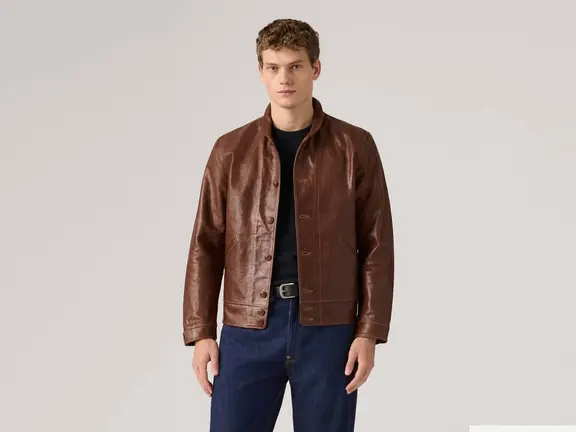















Comments
We love hearing from you. or to leave a comment.